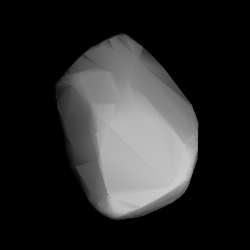
1578 Kirkwood, provisional designation 1951 AT, is a Hilda asteroid from the outermost regions of the asteroid belt, approximately 52 kilometers in diameter. It was discovered on 10 January 1951, by astronomers of the Indiana Asteroid Program at Goethe Link Observatory in Indiana, United States. The asteroid was named after American astronomer Daniel Kirkwood.
1826 Miller, provisional designation 1955 RC1, is a stony Eoan asteroid from the outer region of the asteroid belt, approximately 24 kilometers in diameter.
1994 Shane, provisional designation 1961 TE, is a dark Adeonian asteroid from the central region of the asteroid belt, approximately 25 kilometers in diameter.

1996 Adams, provisional designation 1961 UA, is a stony Eunomia asteroid from the middle region of the asteroid belt, approximately 13 kilometers in diameter. It was discovered on 16 October 1961, by the Indiana Asteroid Program at Goethe Link Observatory near Brooklyn, Indiana, United States. It was later named after mathematician John Couch Adams.
2059 Baboquivari, provisional designation 1963 UA, is an asteroid classified as near-Earth object of the Amor group, approximately 1.9 kilometers in diameter. Discovered by the Indiana Asteroid Program in 1963, it was later named after the Baboquivari Mountains in Arizona, United States.

9902 Kirkpatrick, provisional designation 1997 NY, is a Florian asteroid from the inner regions of the asteroid belt, approximately 4 kilometers in diameter. The asteroid was discovered on 3 July 1997, by American amateur astronomer Paul Comba at Prescott Observatory in Arizona, United States, and named after American musician Ralph Kirkpatrick.

9903 Leonhardt, provisional designation 1997 NA1, is a dark asteroid from the outer region of the asteroid belt, approximately 10 kilometers in diameter.

9971 Ishihara is a stony Flora asteroid from the inner regions of the asteroid belt, approximately 5 kilometers in diameter. It was discovered by Japanese amateur astronomers Kin Endate and Kazuro Watanabe at Kitami Observatory on 16 April 1993, and named after Takahiro Ishihara, president of the astronomical society at Hiroshima.
3037 Alku, provisional designation 1944 BA, is a carbonaceous asteroid from the central region of the asteroid belt, approximately 20 kilometers in diameter. It was discovered on 17 January 1944, by Finnish astronomer Yrjö Väisälä at Turku Observatory in Southwest Finland.
7505 Furusho, provisional designation 1997 AM2, is a stony asteroid and sizable Mars-crosser on an eccentric orbit from the asteroid belt, approximately 10 kilometers (6.2 miles) in diameter. It was discovered on 3 January 1997, by Japanese astronomer Takao Kobayashi at the Ōizumi Observatory in the Kantō region of Japan. The assumed S-type asteroid is likely elongated in shape and has a rotation period of 4.1 hours. It was named for Japanese astronomer Reiko Furusho.
7675 Gorizia, provisional designation 1995 WT5, is a background asteroid from the inner regions of the asteroid belt, approximately 3 kilometers in diameter. It was discovered on 23 November 1995, by the staff at Farra d'Isonzo Observatory in northeastern Italy. It is named for the Italian town of Gorizia.
17683 Kanagawa (provisional designation 1997 AR16) is a carbonaceous background asteroid from the outer region of the asteroid belt, approximately 22 kilometers (14 miles) in diameter. It was discovered on 10 January 1997, by Japanese astronomer Atsuo Asami at the Hadano Observatory, located 60 kilometers southwest of Tokyo, Japan. The asteroid was later named after the Japanese Kanagawa Prefecture.
1817 Katanga, provisional designation 1939 MB, is a stony Phocaea asteroid in from the inner regions of the asteroid belt, approximately 16 kilometers in diameter. It was discovered on 20 June 1939, by English-born South African astronomer Cyril Jackson at Johannesburg Observatory in South Africa. It is named for the Katanga Province.
9344 Klopstock, provisional designation 1991 RB4, is a background asteroid from the inner regions of the asteroid belt. It was discovered on 12 September 1991, by German astronomers Freimut Börngen and Lutz Schmadel at the Karl Schwarzschild Observatory in Tautenburg, Germany. Poor observational data suggests that the asteroid is one of the darkest known objects with a diameter of approximately 17 kilometers (11 miles), while it is also an assumed stony asteroid with a much smaller diameter. It has a rotation period of 5.84 hours and was named after German poet Friedrich Gottlieb Klopstock.
1951 Lick, provisional designation 1949 OA, is a rare-type asteroid and Mars-crosser, approximately 5.6 kilometers in diameter. It was discovered on 26 July 1949, by American astronomer Carl Wirtanen at Lick Observatory on the summit of Mount Hamilton, California, and named for American philanthropist James Lick.
5641 McCleese, provisional designation 1990 DJ, is a rare-type Hungaria asteroid and slow rotator, classified as Mars-crosser from the innermost regions of the asteroid belt, approximately 4 kilometers in diameter.
4332 Milton, provisional designation 1983 RC, is a background asteroid from the central regions of the asteroid belt, approximately 11 kilometers in diameter. It was discovered on 5 September 1983, by American astronomer Carolyn Shoemaker at the Palomar Observatory in California. The X e-subtype has a rotation period of 3.3 hours. It was named after Daniel Milton, American geologist with the USGS.
2995 Taratuta, provisional designation 1978 QK, is a stony Eunomian asteroid from the middle region of the asteroid belt, approximately 17 kilometers in diameter. It was discovered on 31 August 1978, by Russian astronomer Nikolai Chernykh at the Crimean Astrophysical Observatory, Nauchnyj, on the Crimean peninsula. The asteroid was later named after Soviet writer Yevgeniya Taratuta.
1535 Päijänne, provisional designation 1939 RC, is an asteroid from the outer region of the asteroid belt, approximately 25 kilometers in diameter. It was discovered on 9 September 1939, by Finnish astronomer Yrjö Väisälä at the Turku Observatory in Southwest Finland. It was later named for Lake Päijänne.
185638 Erwinschwab (provisional designation 2008 EU7) is a potentially sub-kilometer Nysian asteroid from the inner regions of the asteroid belt. It was discovered on 1 March 2008, by OAM-astronomers at the La Sagra Observatory in southern Spain. The asteroid is estimated to measure between 950 meters and 1.8 kilometers in diameter and was named after German astronomer Erwin Schwab in 2009.





